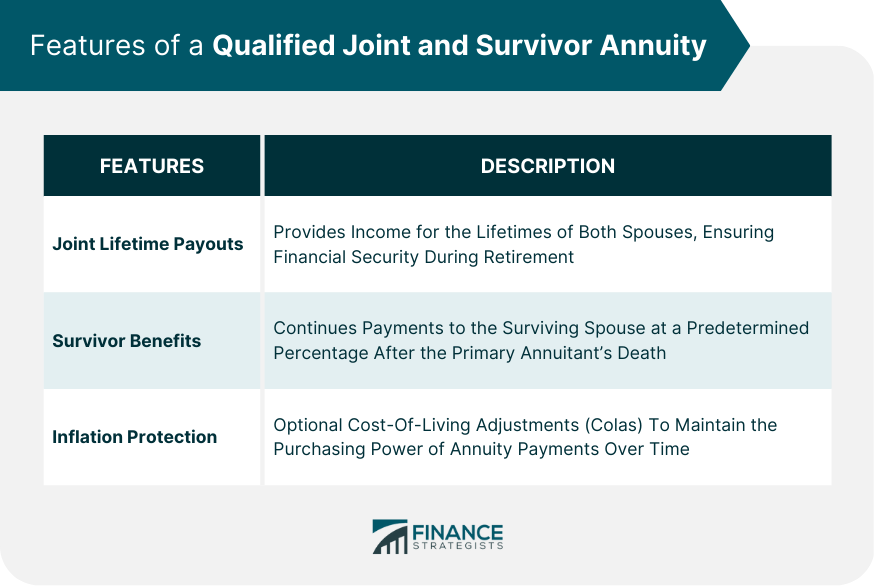A Qualified Joint and Survivor Annuity (QJSA) is a type of annuity that provides a guaranteed income to a retiree and their spouse for the duration of their lives. Upon the death of one spouse, the QJSA continues to pay a predetermined percentage of the original annuity amount to the surviving spouse. The main purpose of a QJSA is to ensure that both spouses have a steady stream of income during retirement. It offers financial security and protection for the surviving spouse, reducing the risk of financial hardship after the death of the primary annuitant. Incorporating a QJSA into retirement planning can help couples maintain their desired lifestyle and meet their financial needs during their retirement years. A QJSA can be a valuable component of a comprehensive retirement plan, providing peace of mind for both spouses. A QJSA is designed to provide income to two annuitants, typically a married couple. The annuity payments are calculated based on the life expectancies of both individuals, ensuring that the payments will last for the duration of both their lives. QJSA payments continue for the lifetime of both spouses, ensuring that the surviving spouse receives income even after the death of the primary annuitant. This feature provides financial stability and reduces the risk of financial hardship for the surviving spouse. When purchasing a QJSA, the couple can choose the percentage of the original annuity amount that will be paid to the surviving spouse upon the death of the primary annuitant. Common options include 50%, 66.67%, 75%, or 100% of the original amount, allowing the couple to customize their QJSA according to their financial needs and preferences. The survivor benefits of a QJSA provide financial security for the surviving spouse, reducing the risk of financial difficulties after the death of the primary annuitant. This protection is particularly important for couples with a significant difference in age or earning capacity. Some QJSAs offer Cost-Of-Living Adjustments (COLAs) to help maintain the purchasing power of the annuity payments over time. These adjustments are typically tied to an inflation index, such as the Consumer Price Index (CPI), and can help protect annuitants from the eroding effects of inflation during their retirement years. Inflation protection is a critical feature for annuities, as it helps ensure that the annuitants can maintain their desired lifestyle and meet their financial needs, even as the cost of living increases over time. The Employee Retirement Income Security Act (ERISA) sets forth requirements for pension plans, including the provision of a QJSA as the default option for married participants. This ensures that both spouses are protected by the annuity's guaranteed income stream unless they opt for a different form of payout with the written consent of both parties. Under ERISA, spousal consent is required for any distribution option other than a QJSA. This provision ensures that both spouses are aware of and agree to the chosen distribution method, protecting the interests of the non-participant spouse. QJSA payments are subject to federal income tax but are generally exempt from Social Security and Medicare taxes. The portion of each annuity payment considered a return of the annuitant's investment is not taxed, while the portion considered earnings are subject to income tax. QJSAs are subject to the Internal Revenue Code's Required Minimum Distribution (RMD) rules, which mandate that annuity payments must begin by a certain age, typically 73. This ensures that the annuitants receive their retirement benefits in a timely manner and prevents them from deferring taxation on their retirement savings indefinitely. A single life annuity provides income for the lifetime of one individual, with payments ceasing upon their death. In contrast, a QJSA provides income for the lifetimes of both spouses, with reduced payments continuing for the surviving spouse after the primary annuitant's death. Unlike a QJSA, a single life annuity does not offer any survivor benefits, leaving the surviving spouse without a guaranteed source of income upon the death of the primary annuitant. A joint life annuity provides income for the lifetimes of two individuals, similar to a QJSA. However, the key difference is that joint life annuity payments cease upon the death of the second annuitant, whereas QJSA payments continue for the surviving spouse. Joint life annuities may allow the annuitants to choose additional beneficiaries, such as children or other family members, whereas a QJSA typically only provides income for the married couple. A period certain annuity guarantees an income for a specified period, such as 10 or 20 years. If the annuitant dies during the guaranteed period, the remaining payments are made to their designated beneficiary. While a period certain annuity can provide survivor benefits, the income stream is not guaranteed for the lifetime of the surviving spouse, unlike a QJSA. Couples should evaluate their financial needs and retirement goals when selecting a QJSA, considering factors such as desired lifestyle, expected expenses, and other income sources. The health and life expectancies of both spouses should be taken into account, as this can impact the overall value and suitability of a QJSA. Couples should consider the potential impact of inflation and market risks on their retirement income and choose a QJSA with features, such as COLAs, that can help mitigate these risks. Couples should evaluate their retirement goals and objectives, ensuring that their chosen QJSA aligns with their desired retirement lifestyle and financial security. When selecting a QJSA, couples should consider other sources of retirement income, such as Social Security benefits, pensions, and personal savings, to determine the most suitable annuity option. QJSAs are often available through employer-sponsored pension plans, making them a convenient option for many employees. Participants can choose a QJSA as their default distribution option, ensuring lifetime income for both spouses during retirement. Individuals can purchase a QJSA using funds from their Individual Retirement Account (IRA), providing a guaranteed income stream during retirement. This option can be particularly beneficial for those without access to an employer-sponsored pension plan. QJSAs can also be purchased directly from private insurance companies. Couples should research and compare offerings from different companies to find a QJSA that meets their needs and preferences. Working with an insurance broker or planner can help couples navigate the process of purchasing a QJSA, ensuring they make informed decisions that align with their financial goals and retirement objectives. A QJSA plays a critical role in providing financial security for both spouses during retirement. By offering a guaranteed income stream for the lifetimes of both spouses, a QJSA can help ensure that couples can maintain their desired lifestyle and meet their financial needs, even after the death of the primary annuitant. Couples should carefully consider various factors, such as financial needs, life expectancy, inflation risks, retirement goals, and other income sources when selecting a QJSA that meets their needs and preferences. It's important for couples to consider factors such as financial needs, life expectancy, inflation risks, retirement goals, and other income sources when selecting a QJSA. To navigate the complexities of purchasing a QJSA and ensure the best possible outcome, we strongly recommend hiring the services of a professional insurance broker. Definition of Qualified Joint and Survivor Annuity (QJSA)
Features of a Qualified Joint and Survivor Annuity
Joint Lifetime Payouts
Survivor Benefits
Inflation Protection

Legal Requirements and Regulations
Employee Retirement Income Security Act (ERISA)
Internal Revenue Code (IRC) Provisions
Comparison to Other Annuity Options
Single Life Annuity
Joint Life Annuity
Period Certain Annuity
Factors to Consider When Choosing a QJSA
Financial Needs of Both Spouses
Life Expectancy and Health
Inflation and Market Risks
Retirement Goals and Objectives
Availability of Other Income Sources

How to Purchase a QJSA
Employer-Sponsored Pension Plans
Individual Retirement Accounts (IRAs)
Private Insurance Companies
Insurance Brokers and Planners
The Bottom Line
Qualified Joint and Survivor Annuity (QJSA) FAQs
A Qualified Joint and Survivor Annuity (QJSA) is a type of annuity that provides guaranteed income to a retiree and their spouse for the duration of their lives. Upon the death of one spouse, the QJSA continues to pay a predetermined percentage of the original annuity amount to the surviving spouse, ensuring financial security and stability during retirement.
The survivor benefits of a QJSA provide financial security for the surviving spouse after the primary annuitant's death. When purchasing a QJSA, the couple can choose the percentage of the original annuity amount that will be paid to the surviving spouse, with common options including 50%, 66.67%, 75%, or 100% of the original amount.
Yes, QJSAs are subject to the Employee Retirement Income Security Act (ERISA), which requires pension plans to offer a QJSA as the default option for married participants. Additionally, QJSAs must adhere to Internal Revenue Code provisions, including required minimum distribution rules and tax treatment guidelines.
A QJSA differs from other annuity options, such as single life annuities, joint life annuities, and period certain annuities, primarily in its provision of lifetime income for both spouses and survivor benefits for the surviving spouse. These features ensure financial security and stability for the couple during retirement.
When selecting a QJSA, couples should consider their financial needs, life expectancy and health, inflation and market risks, retirement goals and objectives, and the availability of other income sources. Consulting with an insurance broker can help in making an informed decision that aligns with their financial goals and retirement objectives.
True Tamplin is a published author, public speaker, CEO of UpDigital, and founder of Finance Strategists.
True is a Certified Educator in Personal Finance (CEPF®), author of The Handy Financial Ratios Guide, a member of the Society for Advancing Business Editing and Writing, contributes to his financial education site, Finance Strategists, and has spoken to various financial communities such as the CFA Institute, as well as university students like his Alma mater, Biola University, where he received a bachelor of science in business and data analytics.
To learn more about True, visit his personal website or view his author profiles on Amazon, Nasdaq and Forbes.











